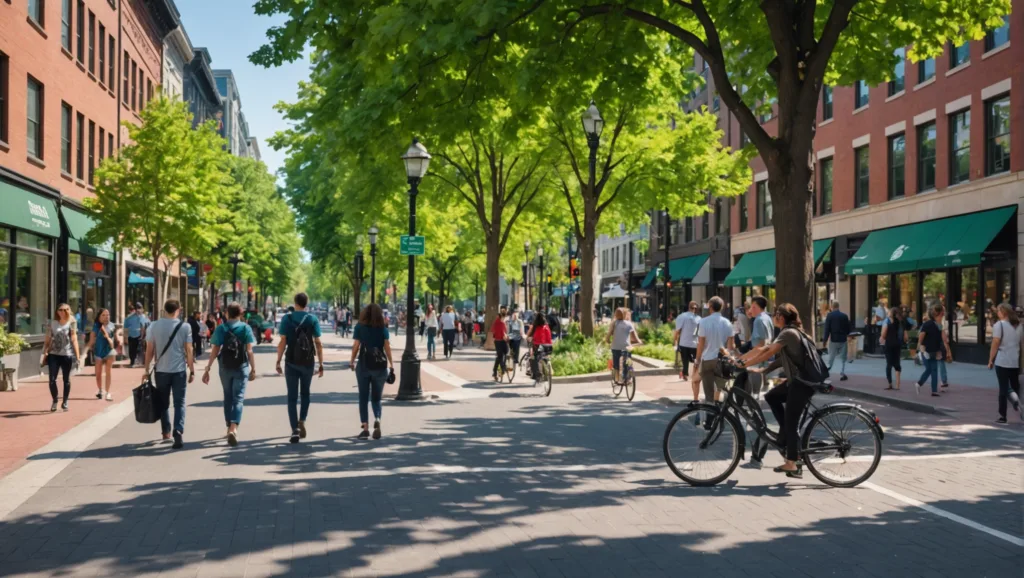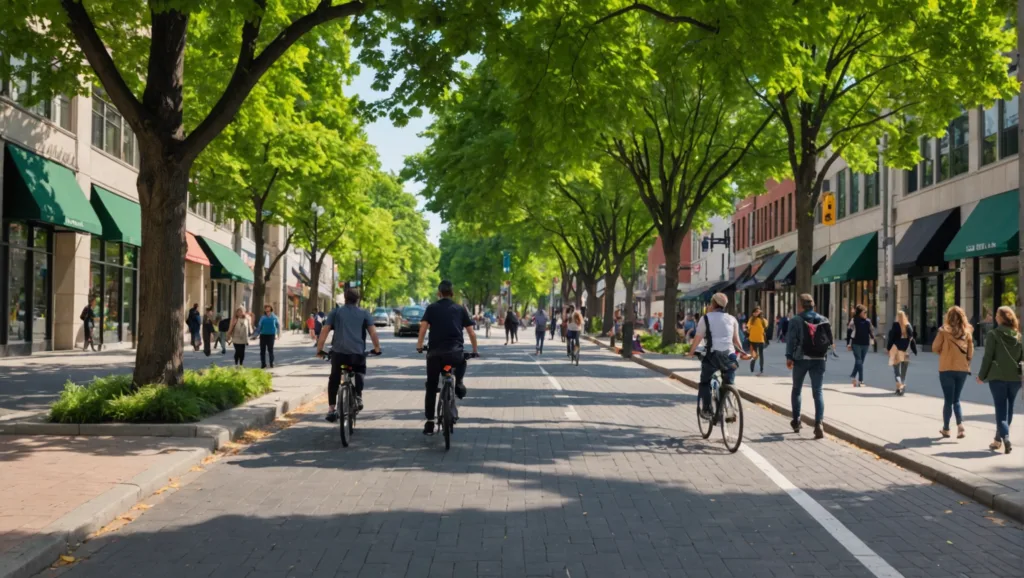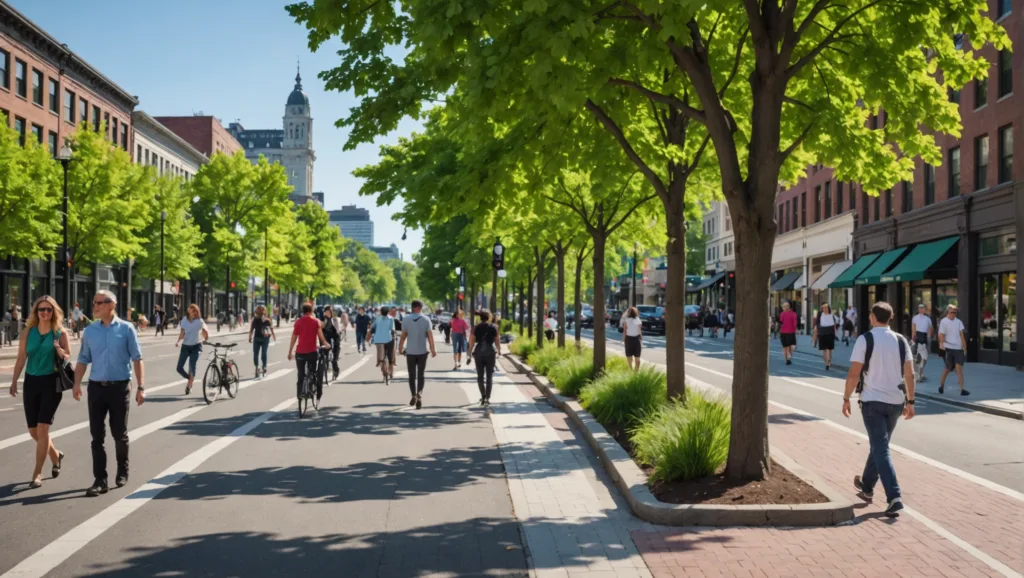Introduction to Pedestrian-Friendly Policies
Introduction to pedestrian-friendly policies is a crucial aspect in shaping modern urban environments. At the core of these policies is the focus on encouraging walking and promoting a more sustainable mobility culture in urban areas. Pedestrian-friendly policies recognize that walkability, as a concept, extends beyond just the mere ability to walk. It incorporates aspects of safety, comfort, accessibility, and enjoyment and, hence, sews together such diverse concerns as pedestrian safety, traffic congestion, mixed land use, accessibility of urban areas, public transport mode, and the environmental conditions at the urban level. Essentially, the policies aim to create walking-friendly cities where residents and visitors can enjoy good walking routes that traverse vibrant public spaces.
Such policies prioritize transforming sidewalks and other pedestrian infrastructures into safe and inviting spaces that promote walking behavior. This means addressing the complex relationships between land use, built environment, and walking behavior through informed urban planning. Several methods are typically employed to achieve this, including:
- Increasing the safety of pedestrians through improved crosswalk design and other measures.
- Enhance walkability by ensuring short distances between key destinations.
- Promoting mixed land use to bring diverse amenities closer to residential areas.
- Improving accessibility to public transport, ensuring cities across many countries and cities are comfortable and practical for people to walk.
- Reducing traffic congestion in city centers, thereby making it easier for people to walk or cycle.
These actions necessitate an ongoing evaluation of the benefits, using metrics related to walking distance, ease of walking, pedestrian movement, and other environmental factors, to ensure the policies respond effectively to people’s needs. Furthermore, pedestrian-friendly policies align closely with wider sustainability goals, as they support more energy-efficient modes of transport like walking and cycling. They help to shape urban sustainability scenarios that balance human mobility needs with environmental stewardship.

Thus, pedestrian-friendly policies hold profound implications for future urban development, leading to the creation of cities that not only prioritize health and sustainability but also enrich the walking experience. In addition to good walking routes and safe crossing, promoting walking and cycling also requires a commitment to maintaining walking and cycling infrastructure. The provision of ample, safe, and comfortable pedestrian and cycling infrastructure in high-density areas around the city center can significantly enhance a city’s walkability.
The World Health Organization’s growing promotion of pedestrian-friendly cities, also known as “Healthy Cities,” is a testament to the relevance and necessity of these policies in our quest for sustainable urban living. Finally, introducing pedestrian-friendly policies contributes greatly to a city’s overall charm, making these urban environments attractive to live in, visit, or do business. Lastly, pedestrian-friendly policies ensure a city embraces all pedestrians and cyclists equally. Creating cities that foster good walking behavior, offers multiple benefits for both people and the environment, as it supports physical activity, reduces vehicular traffic, and enhances social cohesion. For this reason, many cities are prioritizing the introduction and enforcement of these policies, as they strive to balance rapid urbanization with sustainable land use, public health, and quality of life. By adopting pedestrian-friendly policies, cities around the world can create thriving, sustainable, and inclusive urban communities that champion the needs and aspirations of every resident and visitor.
Understanding Walkability in the Built Environment
Walkability in the built environment is an essential aspect to consider in urban planning. It refers to how conducive an area of a city is for walking and how the quality of the pedestrian experience can be impacted by various factors within a built environment. By creating walkable cities, we encourage people to walk more and thereby, foster more sustainable transportation procedures. A walking-friendly environment is not only about developing good walking infrastructure, but it requires sophisticated planning that is essential for cities to make them more accessible. While every city has its own unique culture, a blend of the static and ever-evolving dynamics of the local community and the place, understanding these subtleties can profoundly affect how we design cities to create walking-friendly environments.
Notably, walking is the most natural and cost-effective form of mobility, with numerous benefits to both the individual and the society at large. It minimizes congestion, reduces pollution, improves pedestrian safety, fosters physical activity, and improves the overall well-being of the citizens. The varied benefits of walkability extend to being key drivers of economic growth, enhancing social interaction, and contributing to the livability and vitality of urban spaces. Making cities walking-friendly is not a small task. The case studies of successful European cities suggest that pedestrians’ enhancement and dominance in cities are key to their overall success. A recent survey in the city of Copenhagen, known for its highly walkable areas, showed significant levels of walking and cycling.
The following measures can significantly improve walkability:
- Integrating mixed-use developments to shorten distances between homes, workplaces, and amenities.
- Improving the safety and infrastructure of public spaces to encourage more foot traffic.
- Planning pedestrian-oriented designs at the city scale that include safe and comfortable pedestrian routes.
- Facilitating perceived walking accessibility with clearly marked and well-lit paths.
Thus, envisioning a car-free city or large areas around well-designed pedestrian zones and cycling-friendly routes is integral to creating cities that embrace not just sustainability, but also the health and happiness of its residents. It is imperative to harness the power of well-planned pedestrian-friendly environments on walking to ensure our cities are healthier and more vibrant. With the right approach and commitment, we can make walking an attractive option for everyday transportation in cities across the world.

Strategies for Enhancing Cities for Pedestrians
Strategies for enhancing cities for pedestrians often revolve around the development of walking-friendly environments. City planning is essential for cities to improve the overall rates of walking and incorporate cycling options. While each city has its own culture and set of circumstances, the overarching goal remains the same: increase walkability and physical activity for citizens while creating safe cities that benefit the city by enhancing their health, environment, and economy. In shaping a city to be more pedestrian-friendly, improving the walking infrastructure plays a pivotal role. A walkable city not only benefits its residents but also its visitors who prefer to explore the city on foot. According to the World Health Organization, areas of around 1.5 to 3 kilometers are ideal for establishing a pedestrian-friendly environment in large cities.
They suggested the following strategies to create walking-friendly cities, which would boost the best walking environment:
- Expanding and improving the quality of pedestrian pathways and cycling routes
- Reducing traffic speed in areas with high pedestrian activity
- Improving street connectivity and accessibility
- Incorporating streetscape and design elements that encourage walking and enhance the overall pedestrian experience
- Consider varying weather conditions and ensure the pathway is usable at all times
The implementation of these strategies will largely depend on the specific circumstances and needs of individual cities and places. However, consistent with the goal of the article distributed under the terms of promoting pedestrian-friendly environments, every city should strive to improve its pedestrian accessibility and infrastructure. Undeniably, there is a strong correlation between a city’s pedestrian infrastructure built environment and the city’s walkability. As such, these strategies will improve walkability and contribute positively to residents’ overall physical activity.
Role of Sustainability in Pedestrian-Friendly Urban Planning
The role of sustainability in pedestrian-friendly urban planning cannot be overstated and remains a key consideration for city planners worldwide. The integration of sustainable principles into pedestrian-centric planning creates an urban environment that is not only accessible and active but also enduring and resilient, fostering a virtuous cycle of continuous improvement and reinvention. Sustainability is viewed as the cornerstone of people-centric planning, promoting features like utilitarian walkability, reduced carbon footprint, and increased green spaces. By prioritizing cycling and walking through the creation of dedicated paths and bike lanes in the cityscape, urban planning encourages healthier lifestyles, reduces greenhouse gas emissions, and mitigates traffic congestion. Concurrently, city dwellers are incentivized to embrace more eco-friendly modes of day-to-day commuting.

Sustainability in pedestrian-friendly urban planning often involves:
- Designing cities with a mix of land uses to shorten distances between homes, workplaces, and amenities, thus reducing dependency on motorized forms of transportation.
- Employing rainwater harvesting systems in public spaces and parks to promote water efficiency.
- Incorporating green spaces in the form of vertical gardens, parks, and green roofs, to improve air quality and biodiversity.
- Implementing energy-efficient lighting in all public spaces, employing renewable sources where possible.
In conclusion, the role of sustainability in creating pedestrian-friendly cities is a holistic approach that amalgamates the principles of environmental, social, and economic sustainability, delivering urban spaces that are efficient, livable, and resilient.
The Future of Cities: Prioritizing Walking over Driving
In the evolving cityscape of the future, prioritizing walking over driving is a fundamental shift that is gaining momentum worldwide. This trend not only promotes healthier lifestyles, it also helps reduce congestion, curb emissions, and cultivate a sense of community. With cities around the globe contending with traffic congestion and air pollution, there has been a concerted effort to create more pedestrian-friendly urban environments. Encouraging cycling and walking, instead of relying on motor vehicles, allows for a slower pace of life and provides residents with an opportunity to engage and appreciate their surroundings in a wholesome manner.
This pedestrian-first ideology is reflected in the urban planning strategies of forward-thinking cities. In such cities:
- The provision of well-connected sidewalks and cycling lanes takes precedence over extensive road networks.
- There is a conscious effort to maintain a majority of green spaces, allowing walkers and cyclists to coexist safely with nature.
- Public transportation systems are strategically integrated with these paths, encouraging multimodal transport and reducing the dependency on private automobiles.
This strategy not only promotes a healthier lifestyle but also contributes to a city’s sustainability efforts. The challenges in bringing about this transformation are quite substantial but the potential benefits for individuals and communities as a whole make it a worthy and essential pursuit. As cities continue to adapt and grow, the emphasis on walking over driving will likely lead to more vibrant, livable, and environmentally friendly urban spaces, fostering a future where the well-being of residents and the health of the planet are in harmony.
Conclusion
In conclusion, implementing and encouraging activities such as cycling and walking can significantly contribute to a healthier lifestyle both physically and mentally. Cycling, a low-impact exercise, greatly aids in building strength and muscle tone, enhancing cardiovascular fitness, and improving coordination. It not only serves as an eco-friendly means of commuting, it is a cost-effective solution as well. On the other hand, walking, the most basic form of exercise, brings numerous health benefits from lowering the risk of chronic illnesses to enhancing mood and mental well-being. It’s an exercise that requires no special equipment, can be done anywhere, and can fit easily into people’s daily routines. By incorporating both cycling and walking into everyday life, we not only boost our health and fitness but also contribute to a better environment by reducing our dependence on vehicles.
FAQ’s:
Q1. What are pedestrian-friendly policies?
A1. Pedestrian-friendly policies are policies that prioritize walking and cycling in cities, making them more accessible and safe for pedestrians.
Q2. How can cities prioritize walking?
A2. Cities can prioritize walking by implementing pedestrian-friendly policies such as improving infrastructure, increasing access to public transportation, and creating more pedestrian-friendly spaces.
Q3. What are the benefits of pedestrian-friendly policies?
A3. Pedestrian-friendly policies can improve public health, reduce air pollution, and create more vibrant and livable cities.
Q4. How can cities make walking safer?
A4. Cities can make walking safer by improving infrastructure, increasing access to public transportation, and creating more pedestrian-friendly spaces.
Q5. What are the benefits of cycling and walking?
A5. Cycling and walking can improve public health, reduce air pollution, and create more vibrant and livable cities.
Q6. How can cities encourage cycling and walking?
A6. Cities can encourage cycling and walking by implementing pedestrian-friendly policies such as improving infrastructure, increasing access to public transportation, and creating more pedestrian-friendly spaces.
Q7. What are the challenges of implementing pedestrian-friendly policies?
A7. The challenges of implementing pedestrian-friendly policies include finding the necessary funding, gaining public support, and overcoming bureaucratic obstacles.

Nina Jerkovic
Meet Nina Jerkovic, our expert on all things green and sustainable. With a keen eye for eco-friendly living, Nina shares practical tips and insights to help you navigate the world of sustainable choices. Join her on a mission to create a healthier planet through mindful living.


 Pedestrian-Friendly Tourism: Exploring Cities on Foot for Sustainable Travel
Pedestrian-Friendly Tourism: Exploring Cities on Foot for Sustainable Travel
